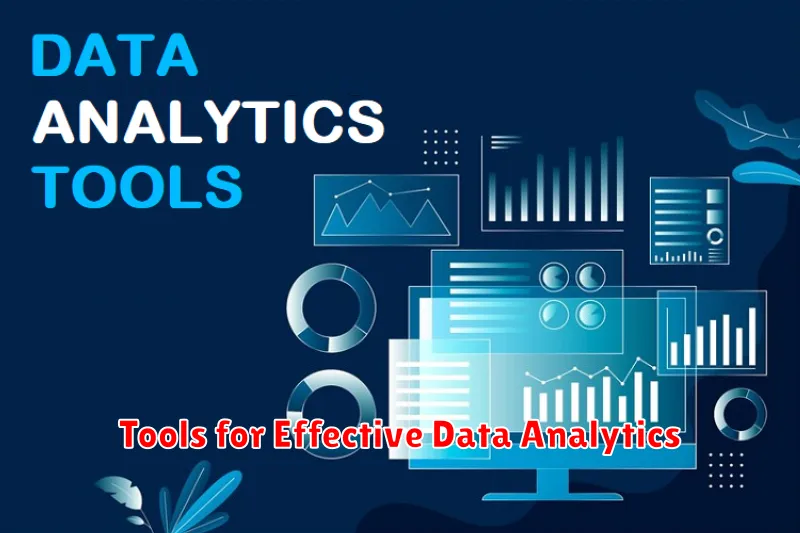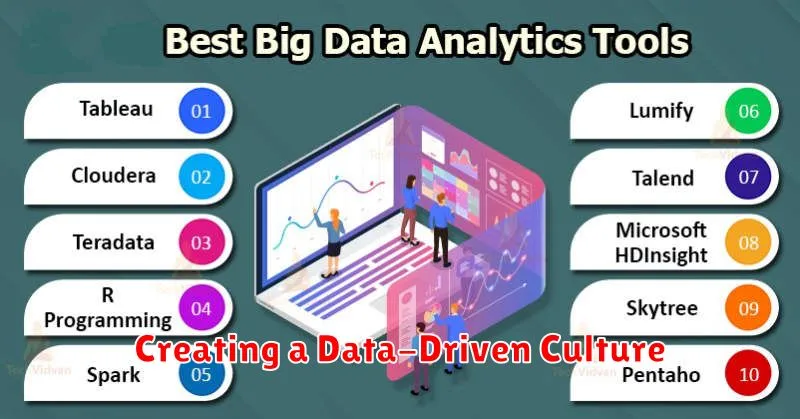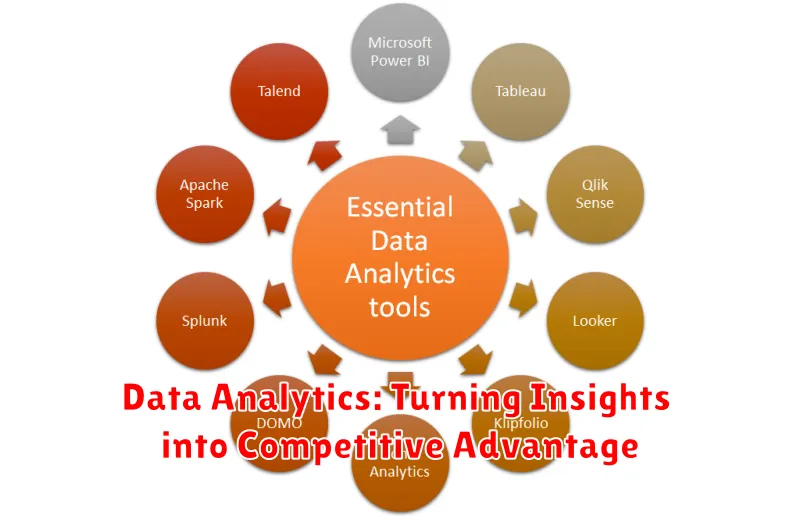In today’s data-driven world, data analytics has become essential for organizations seeking a competitive advantage. Data analytics empowers businesses to transform raw data into actionable insights, driving informed decision-making and strategic planning. Harnessing the power of data analytics allows companies to identify trends, optimize operations, personalize customer experiences, and ultimately achieve sustainable growth in the face of increasing competition. This article will explore the critical role of data analytics in cultivating a competitive advantage, providing a framework for organizations to effectively leverage their data assets.
From predictive analytics forecasting future market trends to prescriptive analytics optimizing resource allocation, the applications of data analytics are vast and transformative. By embracing data-driven insights, businesses can improve operational efficiency, enhance customer relationships, mitigate risks, and develop innovative products and services. This introductory exploration will delve into the key concepts and methodologies of data analytics, highlighting its potential to revolutionize business strategies and unlock unprecedented levels of competitive advantage.
What Is Data Analytics?
Data analytics is the process of examining raw data to draw conclusions about the information it contains. It involves applying logical and analytical reasoning to understand data patterns, trends, and anomalies, ultimately providing valuable insights.
Several different techniques and processes are used, including data mining, machine learning, and statistical analysis. Businesses use data analytics to solve problems and improve decision-making, often leading to increased efficiency, better customer service, and a competitive advantage.
Benefits of Data-Driven Decision Making
In today’s competitive landscape, data-driven decision making is no longer a luxury, but a necessity. Leveraging data analytics empowers organizations to make informed choices that drive positive outcomes.
Improved Accuracy: Data analytics eliminates guesswork and biases, leading to more accurate predictions and decisions. This reduces risks and increases the likelihood of success.
Enhanced Efficiency: By identifying trends and patterns, data analysis helps streamline processes, optimize resource allocation, and improve overall operational efficiency.
Increased Profitability: Data-driven insights can reveal new revenue opportunities, optimize pricing strategies, and minimize costs, ultimately boosting profitability.
Better Customer Understanding: Analyzing customer data provides valuable insights into their preferences and behaviors, enabling businesses to personalize their offerings and improve customer satisfaction.
Tools for Effective Data Analytics

Effective data analysis relies on utilizing the right tools. Choosing the appropriate tools depends on the specific needs of the project, the type of data being analyzed, and the desired outcome. Programming languages such as Python and R are essential for complex analyses, offering powerful libraries for statistical modeling, machine learning, and data visualization.
Business intelligence platforms like Tableau and Power BI provide interactive dashboards and reporting capabilities, allowing users to explore data and generate insights quickly. Database management systems such as SQL are crucial for organizing, storing, and retrieving large datasets. Finally, spreadsheet software like Excel remains a valuable tool for basic data cleaning, manipulation, and analysis.
Selecting the right combination of these tools can empower organizations to effectively analyze their data, uncover valuable insights, and translate those insights into informed decisions.
Understanding Your Business Data
Before diving into complex analytical techniques, it’s crucial to understand the data your business generates. This involves identifying the various data sources, understanding the types of data collected (e.g., transactional, customer, operational), and recognizing the volume and velocity of data inflow.
A clear understanding of your data landscape is the foundation upon which effective data analysis is built. This understanding allows for the identification of key performance indicators (KPIs) relevant to your business objectives. By knowing what data you have, you can begin to formulate questions that data analysis can answer.
Leveraging Predictive Analytics
Predictive analytics empowers businesses to anticipate future outcomes by analyzing historical data, identifying patterns, and building statistical models. This foresight allows organizations to make proactive, data-driven decisions rather than reacting to past events.
Key applications include customer churn prediction, where models identify at-risk customers, enabling targeted retention strategies. Demand forecasting helps optimize inventory management and production planning by predicting future product demand. Risk assessment utilizes predictive models to identify and mitigate potential financial or operational risks.
Implementing predictive analytics involves several stages: data collection and preparation, model building, validation, and deployment. Choosing the right algorithms, such as regression, classification, or time series analysis, depends on the specific business objective and data characteristics. Continuous monitoring and refinement of models are essential for maintaining accuracy and relevance.
Real-Time Analytics for Quick Decisions
In today’s fast-paced business environment, the ability to make quick, informed decisions is paramount. Real-time analytics empowers organizations to analyze data as it’s generated, providing up-to-the-minute insights. This immediate access to information enables businesses to react swiftly to market changes, emerging trends, and customer behavior.
Key benefits of real-time analytics include improved operational efficiency, enhanced customer experiences, and proactive risk management. By monitoring key performance indicators (KPIs) in real time, organizations can identify and address potential issues before they escalate.
Privacy and Ethical Considerations
Data analytics offers powerful tools for gaining competitive advantage, but it also raises important ethical and privacy concerns. Organizations must handle data responsibly, ensuring compliance with relevant regulations like GDPR and CCPA.
Data minimization and purpose limitation are key principles. Collect only necessary data and use it solely for the intended purpose. Transparency is crucial; individuals should know what data is collected, how it’s used, and who has access.
Data security measures must protect against unauthorized access and breaches. Furthermore, organizations need to consider the potential for algorithmic bias and ensure fairness in data analysis and decision-making.
Challenges of Implementing Analytics
Implementing effective data analytics is not without its hurdles. Organizations often face data quality issues, including incomplete, inconsistent, or inaccurate data, hindering accurate analysis.
Another key challenge is the lack of skilled personnel. Finding data scientists and analysts with the expertise to interpret complex datasets and translate insights into actionable strategies can be difficult.
Data silos pose a significant obstacle. Data scattered across different departments and systems makes it challenging to gain a holistic view of the organization and limits the potential for comprehensive analysis.
Finally, defining clear objectives is crucial. Without a clear understanding of the business questions analytics needs to answer, projects can become unfocused and fail to deliver valuable insights.
Case Studies of Successful Data Use
Examining real-world examples illustrates the power of data analytics. One prominent case involves a major retailer using customer purchase data to optimize inventory management. By analyzing buying patterns and trends, they reduced storage costs by 15% and minimized stockouts, ultimately increasing profitability.
Another compelling example comes from the healthcare industry. A leading hospital implemented predictive analytics to identify patients at high risk of readmission. Through data-driven interventions, they successfully reduced readmissions by 10%, resulting in improved patient outcomes and cost savings.
These cases demonstrate how data analytics can be leveraged across diverse industries to achieve tangible business results and gain a competitive edge.
Creating a Data-Driven Culture

Establishing a data-driven culture is crucial for leveraging the full potential of data analytics. This involves shifting mindsets and processes to prioritize data-informed decision making at all levels of the organization.
Key elements of this transformation include fostering data literacy, ensuring data accessibility, and promoting collaboration between data analysts and business stakeholders.
Building data literacy involves empowering employees to understand and interpret data. Accessibility focuses on providing the necessary tools and platforms for easy data access. Collaboration encourages shared understanding and application of insights derived from the data.

